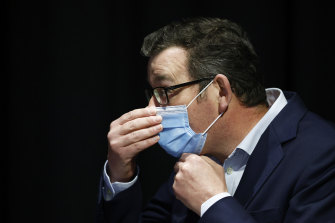Nine months ago, when Daniel Andrews told Victorians “we’re not locking people down any more”, most Victorians took it with a grain of salt.
Following seemingly endless COVID-19 restrictions and constant uncertainty, it was hard to imagine the state government, which long-prided itself on a strict adherence to health advice, would ever reject rules recommended by experts.
However, less than a year later, that’s exactly what the government has done.
Victoria currently has almost 60,000 cases of COVID in the community. New BA.4 and BA.5 sub-variants of the Omicron strain are expected to further drive up daily infection numbers and deaths. Sixteen Victorians died with the virus in the past 24 hours.
However, the state’s new Health Minister Mary-Anne Thomas confirmed the government had rejected advice to introduce compulsory mask mandates in schools, early childhood and retail settings in favour of letting the public “take control of their own health”.
So, how does a government whose leader less than a year ago told beachgoers in Rye that watching the sunset was a breach of lockdown rules, now explain to Victorians that such rules are no longer necessary?
Senior ministers say the government has made a calculation that the vast majority of Victorians no longer have an appetite for government-enforced rules and, even if new restrictions were introduced, few would follow them.
This is backed by pollsters who report that focus groups across the state show no willingness to accept COVID-19 restrictions even in some of the suburbs most heavily impacted by the pandemic, such as Meadow Heights in Melbourne’s north.
Social media may tell a different story. So too, those calling talkback lines and writing to newspapers to demand a stricter approach. But pollsters and politicians believe (or hope) the number of people in favour of mask mandates or other restrictions will be inconsequential.
The government’s decision to instead encourage mask-wearing indoors and in crowded settings is also driven by a belief that mandates would be widely ignored. Ministers point to the low number of mask-wearing commuters on the city’s public transport network where a mandate is still in place, as evidence that rules no longer work.
In many ways, the government is also a victim of its own success. As the virus spreads and more vaccinated people suffer only minor symptoms, the fear factor is reduced making rules more difficult to justify.
Undoubtedly, reintroducing restrictions 19 weeks from polling day would also have electoral ramifications, particularly in outer suburban areas where Labor could find itself in strife.
Internally, Labor MPs believe the government can ignore calls from what it sees as a small section of the community to reintroduce rules because the opposition isn't offering an alternative.
There is a very real risk that the latest wave, which is causing Victoria’s COVID hospital admissions to surge, will exacerbate the problems plaguing the state’s healthcare system, but that is also a risk Labor is willing to take.
Victorian Premier Daniel Andrews made a virtue of listening to health advice.Credit:Getty Images
Ministers insist that while the shambolic state of Victoria’s hospital system exposes the government to considerable risks, it’s a fight it is willing to take on given health has traditionally been safe ground for Labor. They will argue that under the Coalition’s approach, case numbers would have been higher and conditions worse.
The Andrews government prided itself for its strict adherence to health advice, but it is confident this political retreat won't leave it more vulnerable to electoral defeat.
Stay across the most crucial developments related to the pandemic with the Coronavirus Update. Sign up for the weekly newsletter.
Most Viewed in National
From our partners
Source: Read Full Article
